Browse All Articles > Hairpinning in Cisco Pix/ASA
Cisco Pix/ASA hairpinning
The term, hairpinning, comes from the fact that the traffic comes from one source into a router or similar device, makes a U-turn, and goes back the same way it came. Visualize this and you will see something that looks like a hairpin.
Hairpinning is only relevant when the firewall is in routed mode since the "turnaround" of traffic is a routing decision. Also there needs to be another router involved. If the firewall is set up to only pass traffic between interfaces, no hairpinning will be taking place. Typical hairpinning is done when there is a router inside of the firewall beyond which there is another network that needs to be reached to/from the inside network:
![hairpin1]() Another fundament for hairpinning taking place is that not all network equipment has full knowledge of the network topology. Typically, these are computers with only a default route ("default gateway") to something but are not aware of the fact that the remote network is reachable directly via the other router without taking the path via the firewall (see picture above). If the computer had that knowledge it would never involve the firewall.
Another fundament for hairpinning taking place is that not all network equipment has full knowledge of the network topology. Typically, these are computers with only a default route ("default gateway") to something but are not aware of the fact that the remote network is reachable directly via the other router without taking the path via the firewall (see picture above). If the computer had that knowledge it would never involve the firewall.
A workaround like this could be in a Windows-host to add
ver 6.x and prior
No hairpinning was possible. The historic reason for this was that a security feature that prevents interfaces with the same security-level from exchanging traffic. If you needed to isolate two interfaces from each other (but allow each of them to talk to other interfaces) you could give them the same security-level and, by design, there was no traffic allowed between these interfaces no matter of access-list, nat or conduit-configuration. Unfortunately this also meant that since traffic in an out through the same interface was per definition "same security-level", no hair-pinning was possible.
ver 7.0
The command "same-security" was introduced with this version. The purpose with this command was to override the isolation between interfaces having the same security-level. The command has two parameters: "permit-inter-interface" that allows traffic between different interfaces with same security-level and "permit-intra-interface" that allows traffic through the same interface, aka hairpinning. However, with this version the intra-interface-parameter was only functional for vpn-traffic, for example, traffic from an outside vpn-client destined to internet (full tunneling).
ver 7.2
Beginning with v7.2 the "same-security permit-intra-interface"-command becomes useful and can be used for traffic other than vpn-initiated. Now we can do hair-pinning. So, what is needed? First of all, the "same-security permit -intra-interface". Also we need to allow inbound traffic if we have an access-list applied inbound on the interface. Let´s have another look at our example:
![hairpin2]() In this example, we have one host at 192.168.1.100 using the firewall .1 as default gateway. The firewall has a route for the 192.168.2.0/24-network via 192.168.1.2 and the route is directly connected to both networks. Because of this configuration, the traffic from 192.168.1.100 is hair-pinned back, to the router.
In this example, we have one host at 192.168.1.100 using the firewall .1 as default gateway. The firewall has a route for the 192.168.2.0/24-network via 192.168.1.2 and the route is directly connected to both networks. Because of this configuration, the traffic from 192.168.1.100 is hair-pinned back, to the router.
mmand. In the example above, we have no access-list applied. If we have, we must also open for that traffic:
The compilation of relevant configuration lines in the firewall to ackomplish this is shown here:
Ver 8.3
In this version, the nat-concept is totally rewritten with a new command syntax. More about this can be read elsewhere, but the technique is the same. Here is the converted version of the above configuration snippet:
Asymmetric routing
An issue with the configuration above is that since the firewall is stateful (which means that it keeps track of TCP-states) and the fact that traffic in one direction goes via the firewall (from 192.168.1.100 to 192.168.2.200) but the traffic in the other direction goes direct makes the firewall go bananas. If the traffic initiates from the 1-network, all is fine since the firewall allows the initial packet and never sees the return traffic. It might build a quite large list of incomplete sessions that eventually will time out, but it will work:
![hairpin3]() However, when the traffic is initiated from the 2-network, the first packet that will be seen by the firewall is the second (SYN-ACK) which is not very appreciated.
However, when the traffic is initiated from the 2-network, the first packet that will be seen by the firewall is the second (SYN-ACK) which is not very appreciated.
![hairpin4]() Beginning with version 8.2 there is a solution for this in the "tcp state bypass"-functionality. By using this you can with MPF (modular policy framework) specify traffic that should not be handled stateful. Here is an example of doing that.
Beginning with version 8.2 there is a solution for this in the "tcp state bypass"-functionality. By using this you can with MPF (modular policy framework) specify traffic that should not be handled stateful. Here is an example of doing that.
Generally, my solution to hairpinning- and/or asymmetric routing-issues is to avoid it. If you have one or more routers in your topology, it is probably a good idea to use that router as the default gateway instead and only direct traffic to the firewall that should pass it. The drawback of this is that internet-traffic needs to go via the router instead. However, this seldom causes any trouble since the router is not stateful and has no issues with doing hairpinning.
![hairpin5]() Another solution if you need to pass WAN-traffic through the firewall (for security reasons) can be to put the WAN-router(s) on a dedicated firewall interface.
Another solution if you need to pass WAN-traffic through the firewall (for security reasons) can be to put the WAN-router(s) on a dedicated firewall interface.
![hairpin6]()
Conclusion
Hairpinning of traffic in Cisco Pix/ASA and problems with asymmetric routing can be a pain. There are workarounds, but mostly asymmetric issues are symptoms of bad network design rather than configuration issues.
There are more dimensions of hairpinning than just internal traffic turning around to a WAN-router. Such a common example is U-turning of VPN-traffic, for example traffic from an VPN-client going via the firewall out to internet or into another vpn-tunnel. Or spoke-hub-spoke VPN-traffic. This type of traffic seldom gives routing or asymmetric issues, but is more a matter of defining proxy ACL:s for vpn-traffic and not doing NAT on that traffic.
The term, hairpinning, comes from the fact that the traffic comes from one source into a router or similar device, makes a U-turn, and goes back the same way it came. Visualize this and you will see something that looks like a hairpin.
Hairpinning is only relevant when the firewall is in routed mode since the "turnaround" of traffic is a routing decision. Also there needs to be another router involved. If the firewall is set up to only pass traffic between interfaces, no hairpinning will be taking place. Typical hairpinning is done when there is a router inside of the firewall beyond which there is another network that needs to be reached to/from the inside network:
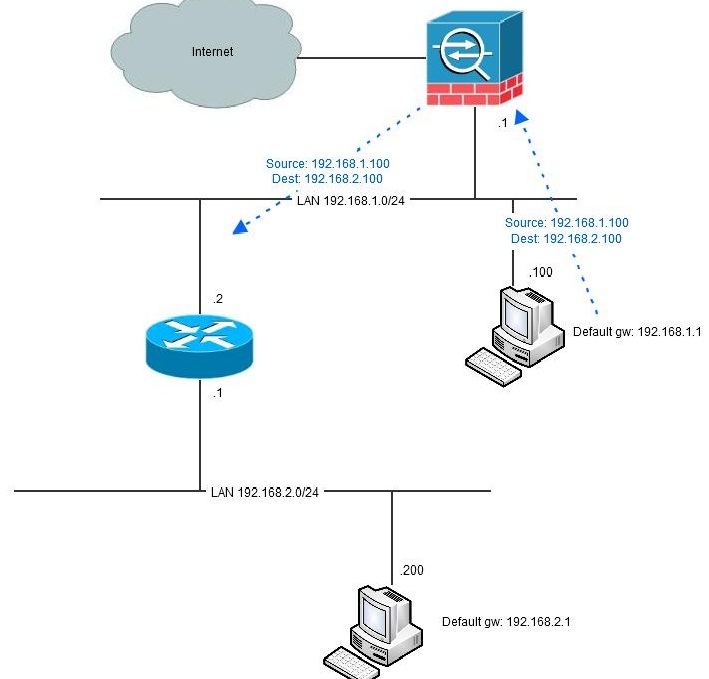 Another fundament for hairpinning taking place is that not all network equipment has full knowledge of the network topology. Typically, these are computers with only a default route ("default gateway") to something but are not aware of the fact that the remote network is reachable directly via the other router without taking the path via the firewall (see picture above). If the computer had that knowledge it would never involve the firewall.
Another fundament for hairpinning taking place is that not all network equipment has full knowledge of the network topology. Typically, these are computers with only a default route ("default gateway") to something but are not aware of the fact that the remote network is reachable directly via the other router without taking the path via the firewall (see picture above). If the computer had that knowledge it would never involve the firewall.
A workaround like this could be in a Windows-host to add
route -p 192.168.2.0 mask 255.255.255.0 192.168.1.2ver 6.x and prior
No hairpinning was possible. The historic reason for this was that a security feature that prevents interfaces with the same security-level from exchanging traffic. If you needed to isolate two interfaces from each other (but allow each of them to talk to other interfaces) you could give them the same security-level and, by design, there was no traffic allowed between these interfaces no matter of access-list, nat or conduit-configuration. Unfortunately this also meant that since traffic in an out through the same interface was per definition "same security-level", no hair-pinning was possible.
ver 7.0
The command "same-security" was introduced with this version. The purpose with this command was to override the isolation between interfaces having the same security-level. The command has two parameters: "permit-inter-interface" that allows traffic between different interfaces with same security-level and "permit-intra-interface" that allows traffic through the same interface, aka hairpinning. However, with this version the intra-interface-parameter was only functional for vpn-traffic, for example, traffic from an outside vpn-client destined to internet (full tunneling).
ver 7.2
Beginning with v7.2 the "same-security permit-intra-interface"-co
 In this example, we have one host at 192.168.1.100 using the firewall .1 as default gateway. The firewall has a route for the 192.168.2.0/24-network via 192.168.1.2 and the route is directly connected to both networks. Because of this configuration, the traffic from 192.168.1.100 is hair-pinned back, to the router.
In this example, we have one host at 192.168.1.100 using the firewall .1 as default gateway. The firewall has a route for the 192.168.2.0/24-network via 192.168.1.2 and the route is directly connected to both networks. Because of this configuration, the traffic from 192.168.1.100 is hair-pinned back, to the router.
interface Vlan1
nameif inside
security-level 100
ip address 192.168.1.1 255.255.255.0
!
route inside 192.168.2.0 255.255.255.0 192.168.1.2 1
!
same-security-traffic permit intra-interface
!
no nat-controlaccess-list acl_inside extended permit ip 192.168.2.0 255.255.255.0 192.168.1.0 255.255.255.0
access-list acl_inside extended permit ip 192.168.1.0 255.255.255.0 192.168.2.0 255.255.255.0
access-list acl_inside extended deny ip any any
!
access-group acl_inside in interface insidenat (inside) 1 0.0.0.0 0.0.0.0
global (outside) 1 interface%ASA-3-305006: portmap translation creation failed for icmp src inside:192.168.1.100 dst inside:192.168.2.200 (type 8, code 0)
%ASA-3-305006: portmap translation creation failed for icmp src inside:192.168.1.100 dst inside:192.168.2.200 (type 8, code 0)
%ASA-3-305006: portmap translation creation failed for icmp src inside:192.168.1.100 dst inside:192.168.2.200 (type 8, code 0)
%ASA-3-305006: portmap translation creation failed for icmp src inside:192.168.1.100 dst inside:192.168.2.200 (type 8, code 0)
%ASA-3-305006: portmap translation creation failed for icmp src inside:192.168.1.100 dst inside:192.168.2.200 (type 8, code 0)static (inside,inside) 192.168.1.0 192.168.1.0 netmask 255.255.255.0
static (inside,inside) 192.168.2.0 192.168.2.0 netmask 255.255.255.0The compilation of relevant configuration lines in the firewall to ackomplish this is shown here:
hostname fw
!
interface Vlan1
nameif inside
security-level 100
ip address 192.168.1.1 255.255.255.0
!
interface Vlan222
nameif outside
security-level 0
ip address dhcp setroute
!
boot system disk0:/asa725-k8.bin
!
same-security-traffic permit intra-interface
!
access-list acl_inside extended permit ip 192.168.2.0 255.255.255.0 192.168.1.0 255.255.255.0
access-list acl_inside extended permit ip 192.168.1.0 255.255.255.0 192.168.2.0 255.255.255.0
access-list acl_inside extended deny ip any any
!
nat-control
!
global (outside) 1 interface
nat (inside) 1 0.0.0.0 0.0.0.0
!
static (inside,inside) 192.168.1.0 192.168.1.0 netmask 255.255.255.0
static (inside,inside) 192.168.2.0 192.168.2.0 netmask 255.255.255.0
!
access-group acl_inside in interface inside
!
route inside 192.168.2.0 255.255.255.0 192.168.1.2 1Ver 8.3
In this version, the nat-concept is totally rewritten with a new command syntax. More about this can be read elsewhere, but the technique is the same. Here is the converted version of the above configuration snippet:
hostname fw
!
interface Vlan1
nameif inside
security-level 100
ip address 192.168.1.1 255.255.255.0
!
interface Vlan222
nameif outside
security-level 0
ip address dhcp setroute
boot system disk0:/asa831-k8.bin
!
same-security-traffic permit intra-interface
!
object network obj-192.168.1.0
subnet 192.168.1.0 255.255.255.0
object network obj-192.168.2.0
subnet 192.168.2.0 255.255.255.0
object network obj_any
subnet 0.0.0.0 0.0.0.0
object network obj_any-01
subnet 0.0.0.0 0.0.0.0
object network obj-0.0.0.0
host 0.0.0.0
!
access-list acl_inside extended permit ip 192.168.2.0 255.255.255.0 192.168.1.0 255.255.255.0
access-list acl_inside extended permit ip 192.168.1.0 255.255.255.0 192.168.2.0 255.255.255.0
access-list acl_inside extended deny ip any any
!
object network obj-192.168.1.0
nat (inside,inside) static 192.168.1.0
object network obj-192.168.2.0
nat (inside,inside) static 192.168.2.0
object network obj_any
nat (inside,outside) dynamic interface
object network obj_any-01
nat (inside,outside) dynamic obj-0.0.0.0
!
access-group acl_inside in interface inside
!
route inside 192.168.2.0 255.255.255.0 192.168.1.2 1Asymmetric routing
An issue with the configuration above is that since the firewall is stateful (which means that it keeps track of TCP-states) and the fact that traffic in one direction goes via the firewall (from 192.168.1.100 to 192.168.2.200) but the traffic in the other direction goes direct makes the firewall go bananas. If the traffic initiates from the 1-network, all is fine since the firewall allows the initial packet and never sees the return traffic. It might build a quite large list of incomplete sessions that eventually will time out, but it will work:
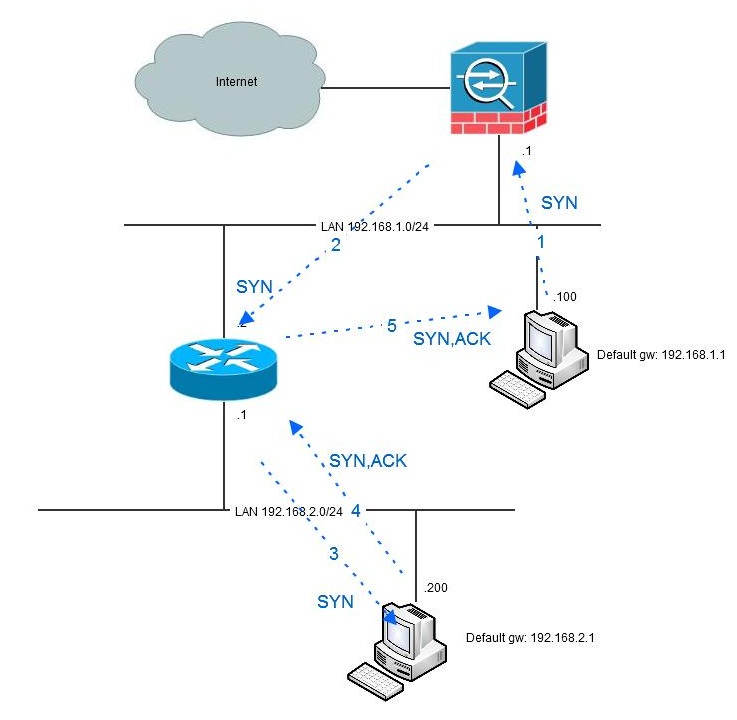 However, when the traffic is initiated from the 2-network, the first packet that will be seen by the firewall is the second (SYN-ACK) which is not very appreciated.
However, when the traffic is initiated from the 2-network, the first packet that will be seen by the firewall is the second (SYN-ACK) which is not very appreciated.
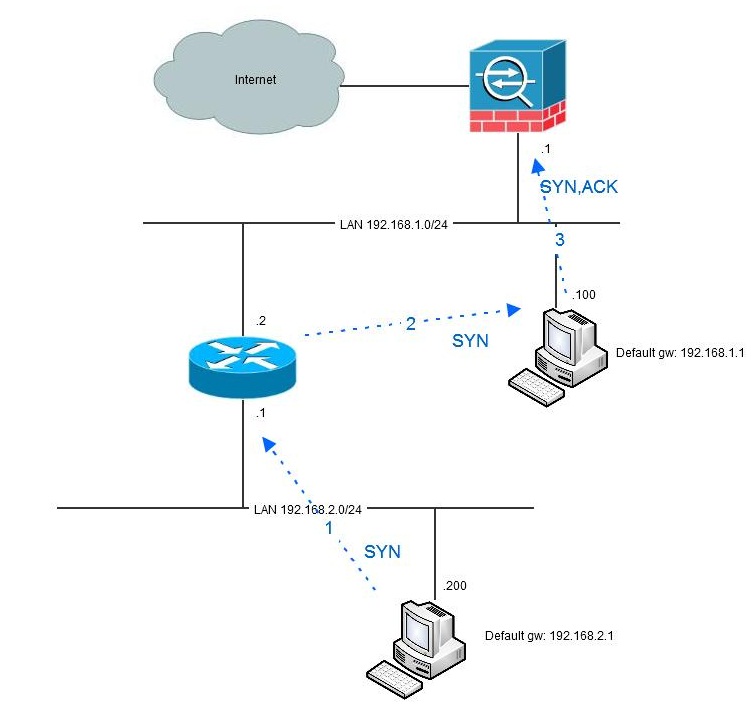 Beginning with version 8.2 there is a solution for this in the "tcp state bypass"-functionality. By using this you can with MPF (modular policy framework) specify traffic that should not be handled stateful. Here is an example of doing that.
Beginning with version 8.2 there is a solution for this in the "tcp state bypass"-functionality. By using this you can with MPF (modular policy framework) specify traffic that should not be handled stateful. Here is an example of doing that.
Generally, my solution to hairpinning- and/or asymmetric routing-issues is to avoid it. If you have one or more routers in your topology, it is probably a good idea to use that router as the default gateway instead and only direct traffic to the firewall that should pass it. The drawback of this is that internet-traffic needs to go via the router instead. However, this seldom causes any trouble since the router is not stateful and has no issues with doing hairpinning.
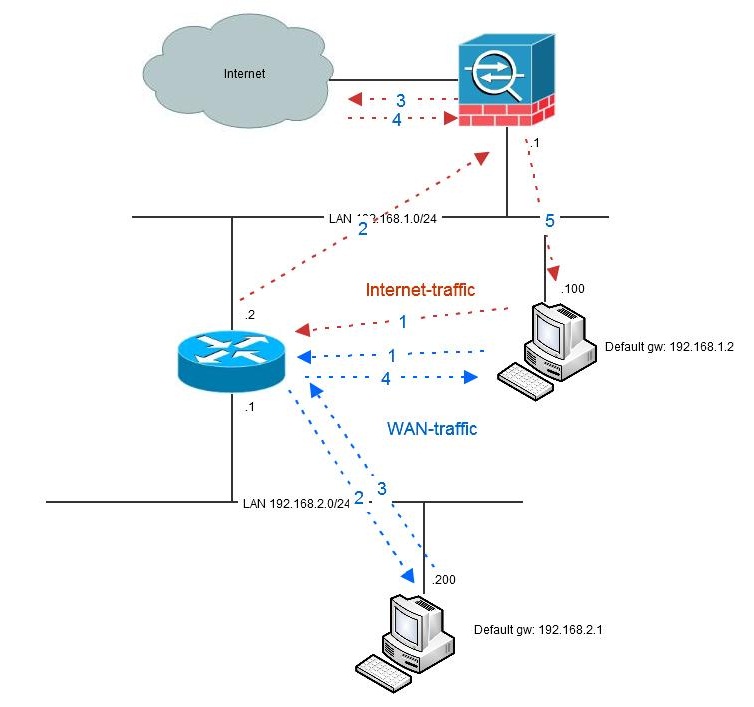 Another solution if you need to pass WAN-traffic through the firewall (for security reasons) can be to put the WAN-router(s) on a dedicated firewall interface.
Another solution if you need to pass WAN-traffic through the firewall (for security reasons) can be to put the WAN-router(s) on a dedicated firewall interface.
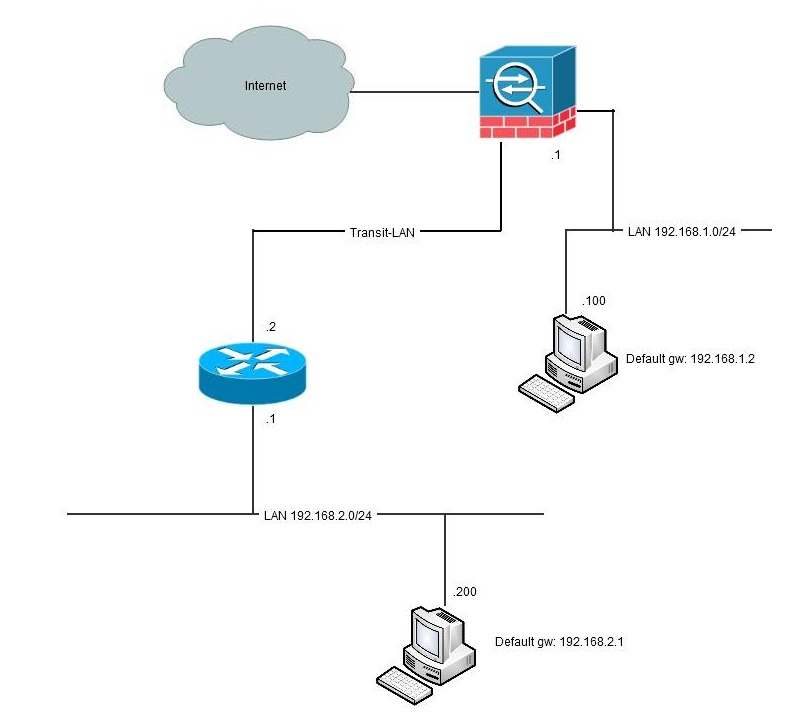
Conclusion
Hairpinning of traffic in Cisco Pix/ASA and problems with asymmetric routing can be a pain. There are workarounds, but mostly asymmetric issues are symptoms of bad network design rather than configuration issues.
There are more dimensions of hairpinning than just internal traffic turning around to a WAN-router. Such a common example is U-turning of VPN-traffic, for example traffic from an VPN-client going via the firewall out to internet or into another vpn-tunnel. Or spoke-hub-spoke VPN-traffic. This type of traffic seldom gives routing or asymmetric issues, but is more a matter of defining proxy ACL:s for vpn-traffic and not doing NAT on that traffic.
Have a question about something in this article? You can receive help directly from the article author. Sign up for a free trial to get started.


Comments (1)
Commented:
You said we needed to add the lines to overcome the effects of the NAT/global.
static (inside,inside) 192.168.1.0 192.168.1.0 netmask 255.255.255.0
static (inside,inside) 192.168.2.0 192.168.2.0 netmask 255.255.255.0
If we had a dozens VPN tunnels could we not just add the below??
static (inside,inside) 192.168.0.0 192.168.0.0 netmask 255.255.0.0